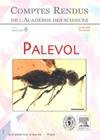伊比利亚大西洋(Lapparent de Broin & Murelaga, 1996) n. comb。:欧洲坎帕尼亚-马斯特里赫特双翅龟的多样性和古生物地理分布的新数据
IF 1.3
4区 地球科学
Q3 PALEONTOLOGY
引用次数: 0
摘要
Bothremydidae是欧洲西南部坎帕尼亚和马斯特里赫特(上白垩纪)化石记录中数量最多的龟类分支。Foxemydina Gaffney, Tong & Meylan, 2006的几个成员在包括法国南部和西班牙东北部的地区都很有名。有问题的“Polysternon”atlanticum是最糟糕的特征,缺乏允许其特定有效性得到确认的诊断,其一般归属已被认为是可疑的。它的存在只被认为是在它的类型地点,即Treviño县(西班牙北部布尔戈斯省)Laño的上坎帕尼亚采石场。尽管在1996年对“Polysternon”atlanticum Lapparent de Broin & Murelaga的描述之后,关于Bothremydidae的知识显著增加,但自20世纪90年代以来,没有关于该物种的新信息发表。对来自Laño的大量未发表的bothrremydid材料的分析使我们能够确认该物种的有效性。作为这项研究的结果,它不仅在其类型地区被确定,而且在西班牙其他地区和法国南部也被确定。欧洲上白垩纪Bothremydidae Baur, 1891的多样性低于先前的考虑。因此,物种“Iberoccitanemys convarum”(Laurent, Tong & Claude, 2002)最初是为法国记录定义的,随后在西班牙也被发现,在这里被确定为Laño中描述的物种的同义词。对上坎帕尼亚至上马斯特里赫特、伊比利亚和大西洋地区的修正诊断(Lapparent de Broin & Murelaga, 1996) n. comb。,建议。本文章由计算机程序翻译,如有差异,请以英文原文为准。
Iberoccitanemys atlanticum (Lapparent de Broin & Murelaga, 1996) n. comb.: new data on the diversity and paleobiogeographic distributions of the Campanian-Maastrichtian bothremydid turtles of Europe
Bothremydidae is the most abundant clade of turtles in the Campanian and Maastrichtian (Upper Cretaceous) fossil record of southwestern Europe. Several members of Foxemydina Gaffney, Tong & Meylan, 2006 are known in an area that includes Southern France and the North-Eastern half of Spain. The problematic ‘Polysternon’ atlanticum is the worst characterized, lacking a diagnosis that allows its specific validity to be confirmed, and whose generic attribution has been recognized as doubtful. Its presence was exclusively proposed in its type locality, the upper Campanian quarry of Laño, in Treviño County (Burgos Province, North of Spain). Despite the fact that knowledge about Bothremydidae has markedly increased after the description of ‘Polysternon’ atlanticum Lapparent de Broin & Murelaga, 1996, no new information about this species has been published since the 1990s. The analysis of abundant unpublished material of the bothremydid from Laño allows us to confirm the validity of this species. As a consequence of this study, it is not only identified in its type locality, but also in other Spanish regions and in the south of France. The diversity of Bothremydidae Baur, 1891 in the Upper Cretaceous of Europe is lower than previously considered. Thus, the species ‘Iberoccitanemys convenarum’ (Laurent, Tong & Claude, 2002), originally defined for the French record, and subsequently also identified in Spain, is identified here as a synonym of the species described in Laño. An emended diagnosis for the upper Campanian to upper Maastrichtian, Iberoccitanemys atlanticum (Lapparent de Broin & Murelaga, 1996) n. comb., is proposed.
求助全文
通过发布文献求助,成功后即可免费获取论文全文。
去求助
来源期刊

Comptes Rendus Palevol
地学-古生物学
CiteScore
2.10
自引率
0.00%
发文量
39
审稿时长
17.6 weeks
期刊介绍:
Comptes Rendus Palevol is a fully electronic and peer-reviewed journal, with a continuous publication stream, devoted to palaeontology, prehistory and evolutionary sciences. It publishes original research results, in French or English, in the following domains: systematic and human palaeontology, prehistory, evolutionary biology and macroevolution, and history of sciences. Thematic issues may also be published under the responsibility of a guest editor. All articles published in Comptes Rendus Palevol are compliant with the different nomenclatural codes. A copyright assignment will be signed by the authors before publication.
 求助内容:
求助内容: 应助结果提醒方式:
应助结果提醒方式:


